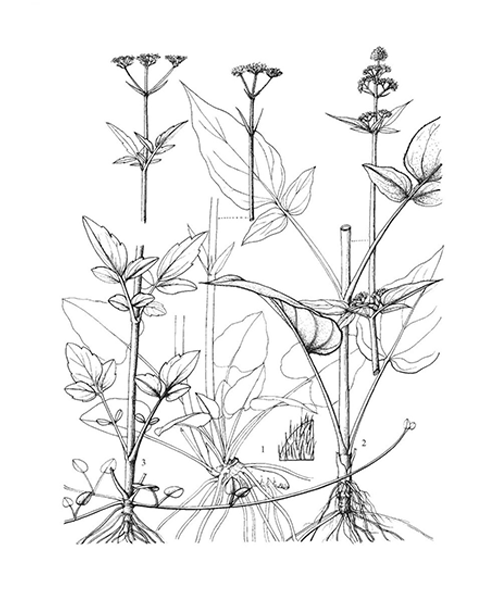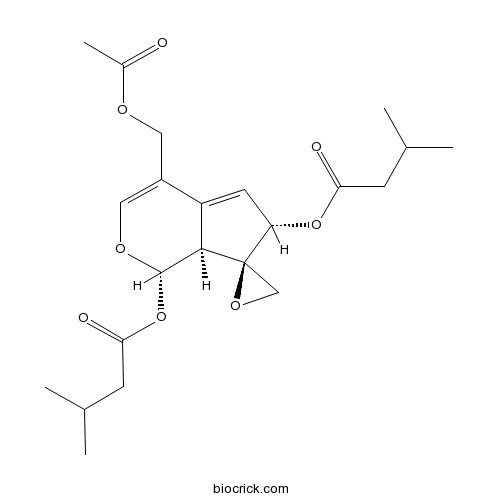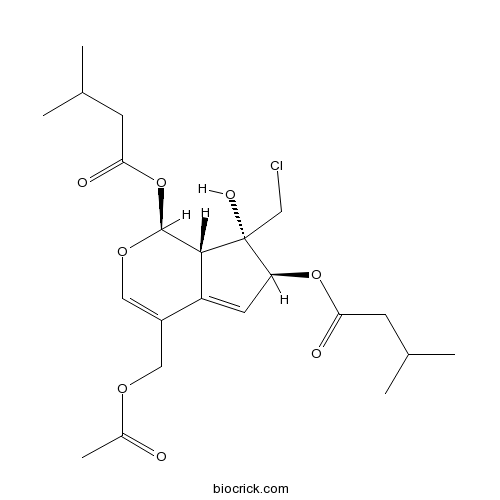Valeriana jatamansi
Valeriana jatamansi
1. The products in our compound library are selected from thousands of unique natural products; 2. It has the characteristics of diverse structure, diverse sources and wide coverage of activities; 3. Provide information on the activity of products from major journals, patents and research reports around the world, providing theoretical direction and research basis for further research and screening; 4. Free combination according to the type, source, target and disease of natural product; 5. The compound powder is placed in a covered tube and then discharged into a 10 x 10 cryostat; 6. Transport in ice pack or dry ice pack. Please store it at -20 °C as soon as possible after receiving the product, and use it as soon as possible after opening.

Natural products/compounds from Valeriana jatamansi
- Cat.No. Product Name CAS Number COA
-
BCN2351
Valepotriate18296-44-1
Instructions

-
BCN2763
Valechlorine51771-49-4
Instructions

-
BCN5687
Magnolol528-43-8
Instructions

Anti-invasion and anti-metastasis effects of Valjatrate E via reduction of matrix metalloproteinases expression and suppression of MAPK/ERK signaling pathway.[Pubmed: 29703569]
Valjatrate E is an iridoid compound extracted from Valeriana jatamansi Jones herb and is the active ingredient in antitumor activity. Here, we reported its action on tumor invasion and metastasis in the human hepatocellular carcinoma HepG2, aiming at a better understanding of the potential mechanism of action of Valjatrate E. HepG2 cells were treated with Valjatrate E at different concentrations. Wound healing assay and transwell chamber assay were used to determine the effects of Valjatrate E on the migration and invasiveness of HepG2 cells, respectively. Moreover, homogeneity and heterotypic adhesion experiments evaluated the adhesion property of HepG2 cells. The molecular mechanisms by which Valjatrate E inhibited the invasion and migration of HepG2 cells were investigated by gelatin zymography experiment and western blot. Treatment with Valjatrate E inhibited the migration and invasion of HepG2 cells. It achieved this by reducing the expression of matrix metalloprotease 2 (MMP-2) and matrix metalloprotease 9 (MMP-9), by inhibition of heterogeneous adhesion ability, by blocking mitogen-activated protein kinase (MAPK) signaling via inhibiting the phosphorylation of extracellular signal-regulated kinases (p-ERK). Taken together, these findings provide new evidence that mitogen-activated protein kinase/extracellular signal regulated kinase (MAPK/ERK) signaling pathway plays an important role in promoting invasion and metastasis in HepG2 cells through p-ERK, and MAPK/ERK signaling pathway may be a therapeutic target for tumor.
[Chemical constituents from ethyl acetate-soluble extraction of Valeriana jatamansi].[Pubmed: 29552818]
Application of a combination of various chromatographic techniques including column chromatography over silica gel, Sephadex LH-20, macroporous adsorbent resin, and reversed-phase HPLC, led to the isolation of 173 compounds including irdidoids, monoterpenes, sesquiterpenes, triterpenes, lignans, flavonoids, and simple aromatic derivatives from the ethyl acetate-soluble fraction of the whole plants of Valeriana jatamansi(Valerianaceae), and their structures were elucidated by spectroscopic methods including 1D, 2D NMR UV, IR, and MS techniques. Among them, 77 compounds were new. In previous reports, we have described the isolation, structure elucidation, and bioactivities of 68 new and 25 known compounds. As a consequence, we herein reported the isolation and structure elucidation of the remaining 9 new and 71 known compounds, the structure revision of valeriotriate A(8a), as well as cytotoxicity of some compounds.
Studies of the structure-antioxidant activity relationships and antioxidant activity mechanism of iridoid valepotriates and their degradation products.[Pubmed: 29232391]
Oxidative stress has been associated with diverse diseases, including obesity, cancer and neurodegeneration. In fact, Valeriana jatamansi Jones (valerian) and its extracts possess strong antioxidant activities that extend their application in clinical practice to the treatment of these illnesses, even though the underlying mechanisms are not well understood. Iridoid valepotriate, a characteristic iridoid ester in valerian with poor chemical stability, possesses considerable antioxidant components. The original compounds and their degradation products have been found to exhibit strong antioxidant activities. However, the relationship between their structure and antioxidant effects and the mechanism underlying their oxidation resistance remain unclear. A forced degradation study using three iridoid valepotriates (valtrate, acevaltrate and 1-β acevaltrate) was performed in this work, and the structures of their degradation products were estimated by TLC-MS and LC-MS. Comparison of the antioxidant activities of the iridoid valepotriates before and after forced degradation revealed that degradation reduced the activities of the iridoid valepotriates in free radical scavenging and cytotoxic and cell apoptosis tests. The results suggested that the oxirane nucleus is important for defining the antioxidant profile of iridoid valepotriate. We uncovered possible mechanisms that could explain the antioxidant activities, including the generation of two hydroxyl groups through intramolecular transfer of an H• from an oxirane ring and a reduction in ROS levels through interactions with GABAergic signalling pathways.
[Effects of baldrinal of Valeriana jatamansi on expression of CRF, TPH1 mRNA and 5-HT in rats with irritable bowel syndrome].[Pubmed: 28948742]
This study aimed to investigate the effects of baldrinal of Valeriana jatamansi on the expression of corticotropin releasing factor (CRF) and tryptophan hydroxylase 1 (TPH1) mRNA and levels of 5-hydroxytryptamine (5-HT) in colon of rats with irritable bowel syndrome (IBS), and to explain its therapeutic mechanism on IBS through 5-HT pathway. Fifty-four male SD rats were randomly divided into 6 groups: blank group, model group, baldrinal high, medium and low dose groups, and pinaverium bromide group, n=9 in each group. The IBS rat models were established by using unpredictable chronic stress for 3 weeks followed by 1-hour acute restraint stress (CAS) after 7 days of rest and independent feeding. CRF expression was detected by IHC-P; TPH1 mRNA expression was detected by using RT-PCR and the 5-HT level was measured by high performance liquid chromatography(HPLC). The results indicated that the method of chronic stress with acute restrain stress method and independent feeding could lead to the increase in expressions of CRF and TPH1 mRNA and levels of 5-HT in IBS rats(P<0.05). The expressions of CRF, TPH1 mRNA and 5-HT in baldrinal groups were significantly lower than those in model group(P<0.05). The experimental results showed that IBS could result in increase in the expressions of CRF, TPH1 mRNA and levels of 5-HT, and the baldrinal of V. jatamansi could improve the symptoms of IBS by reducing the expressions of CRF, TPH1 mRNA and levels of 5-HT in colon of rats.
Cytotoxic and antibacterial activities of iridoids and sesquiterpenoids from Valeriana jatamansi.[Pubmed: 28941743]
None
Anxiolytic potency of iridoid fraction extracted from Valeriana jatamansi Jones and its mechanism: a preliminary study.[Pubmed: 28782383]
Valeriana jatamansi Jones (V. jatamansi) has been widely used for treating anxiety and its mechanism involves many aspects including GABA level. This study aimed to evaluate the anxiolytic potency of an iridoid fraction extracted from the radix and rhizomes of V. jatamansi. The iridoid fraction was extracted by using D101 resin; its major components were analysed preliminarily by thin layer chromatography, ultraviolet spectrophotometry and high-performance liquid chromatography; and its anxiolytic effects at 6 mg/kg (low-dose), 9 mg/kg (medium-dose) and 12 mg/kg (high-dose) were evaluated using the elevated plus maze test, the light-dark box test, the Vogel's drinking conflict test, and the open field drink test. Its action mechanism was investigated using the ELISA. This study provided evidence on the anxiolytic potency of the iridoid fraction from V. jatamansi and revealed its action mechanism of regulating the GABA level.


